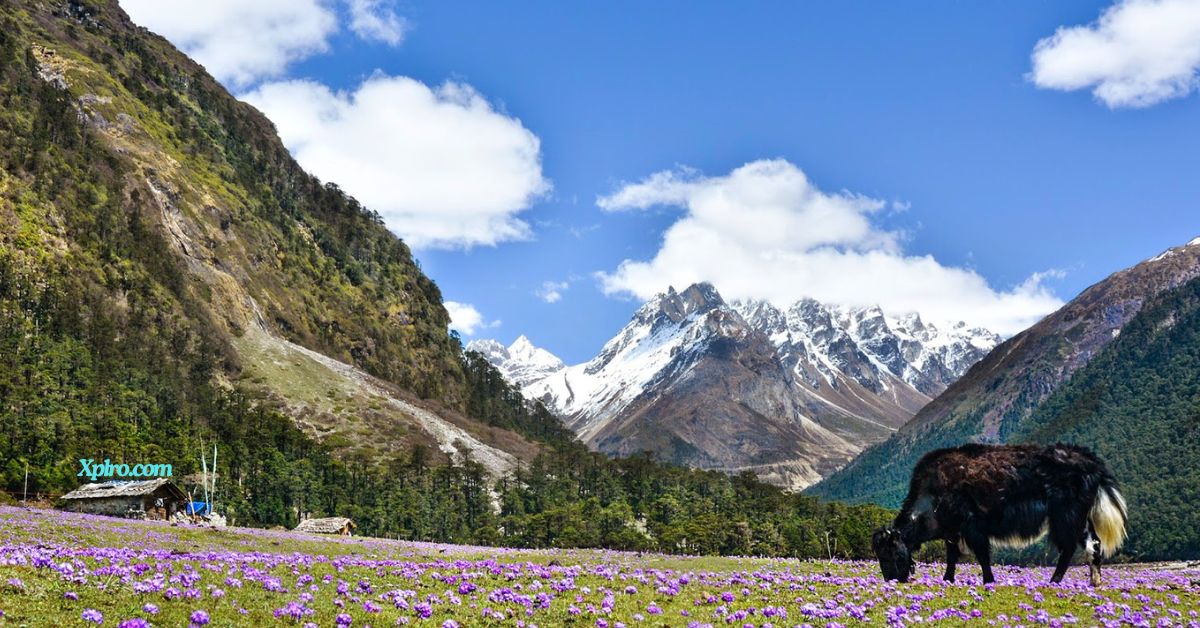Surrounded by the majestic Eastern Himalayas, Sikkim’s Yumthang Valley blossoms as a paradise for nature lovers and adventurers. Nicknamed the “Valley of Flowers,” Yumthang stuns visitors with a captivating display of vibrant blooms, sprawling meadows, and snow-capped peaks that pierce the sky. Reaching an altitude of 11,693 feet, this pristine valley remains a sanctuary of tranquility and breathtaking beauty, beckoning travelers worldwide to witness its seasonal transformations.
Spring paints the valley in a riot of color, with rhododendrons, primulas, and a mesmerizing array of wildflowers bursting across the landscape. The scene transforms into a breathtaking spectacle, resembling a scene straight out of a fairytale. Winter, however, offers a contrasting yet equally captivating experience.
How to reach:
By Air:
While Pakyong Airport, situated roughly 140 kilometers away, is the closest airbase to Yumthang Valley, its limited connections often lead travelers to opt for Bagdogra Airport in West Bengal. This airport sits about 220 kilometers from the valley. Upon arrival at Bagdogra, taxis and shared vehicles are readily available to whisk you to Gangtok, Sikkim’s capital city.
By Train:
For train travel enthusiasts, New Jalpaiguri (NJP) station in West Bengal serves as the closest railway link, approximately 215 kilometers from Yumthang Valley. Thankfully, NJP boasts excellent connections to major Indian cities. Once you arrive at NJP, taxis and shared vehicles can transport you comfortably to Gangtok.
Best time to visit:
Spring: (Late February to Mid-June)
Spring paints Yumthang Valley in a vibrant tapestry, earning its well-deserved nickname, “The Valley of Flowers.” As winter loosens its grip, the valley bursts into life with a dazzling array of blooming rhododendrons, primulas, and a kaleidoscope of other wildflowers. Pleasant weather, with temperatures ranging from a comfortable 6°C to a balmy 20°C, makes it an ideal time for nature walks and capturing the valley’s breathtaking beauty through photography.
Autumn: (September to December)
Autumn offers another delightful window to visit Yumthang Valley. The monsoon rains have passed, giving way to clear skies that showcase breathtaking panoramas of snow-capped peaks. With temperatures hovering between a refreshing 5°C and a comfortable 15°C, the weather is perfect for outdoor activities like trekking and sightseeing.
Winter: (December to February)
Winter transforms Yumthang Valley into a tranquil wonderland, carpeted in a blanket of pristine snow. Temperatures often dip below freezing, creating a magical and peaceful atmosphere. This season is a paradise for snow enthusiasts, offering a unique and enchanting experience amidst the snow-covered landscape.
Attractions:
Shingba Rhododendron Sanctuary:
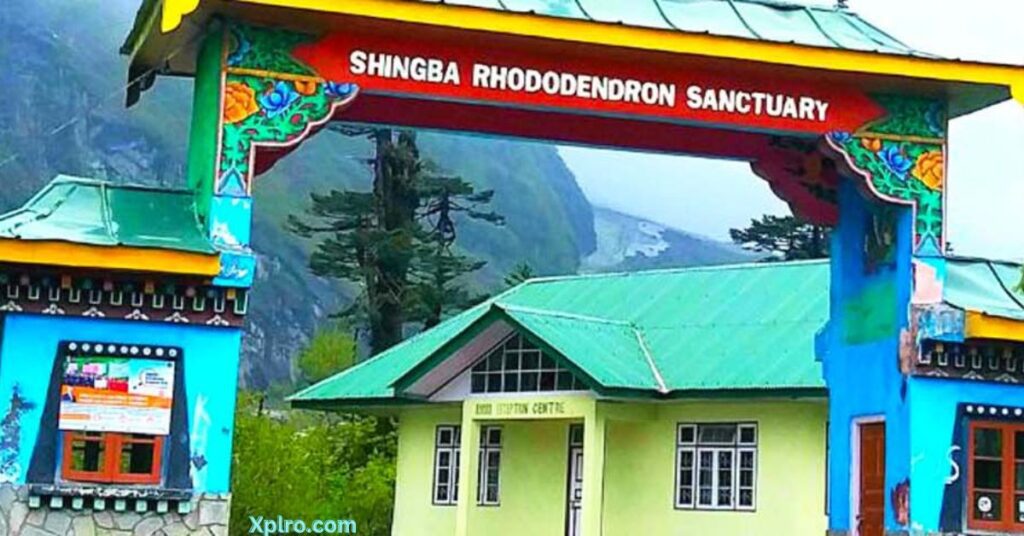
Nestled within the verdant embrace of Yumthang Valley, the Shingba Rhododendron Sanctuary unfolds as a botanical paradise. This 43-square-kilometer haven showcases Sikkim’s incredible floral diversity, boasting over 24 dazzling species of rhododendrons. From late February to mid-June, the sanctuary explodes in a vibrant tapestry of colors, transforming the landscape into a breathtaking spectacle.
Imagine lush meadows carpeted with wildflowers, interwoven with dense pockets of forest and punctuated by cascading streams. This serene and picturesque canvas unfolds before you as you explore the sanctuary. Be prepared to be captivated by a kaleidoscope of colors – rhododendrons in shades of pink, red, purple, and white erupt alongside other alpine blooms like primulas and poppies. Gaze upwards, and you’ll be rewarded with awe-inspiring vistas of snow-capped peaks that majestically frame this floral paradise.
Hot Springs:
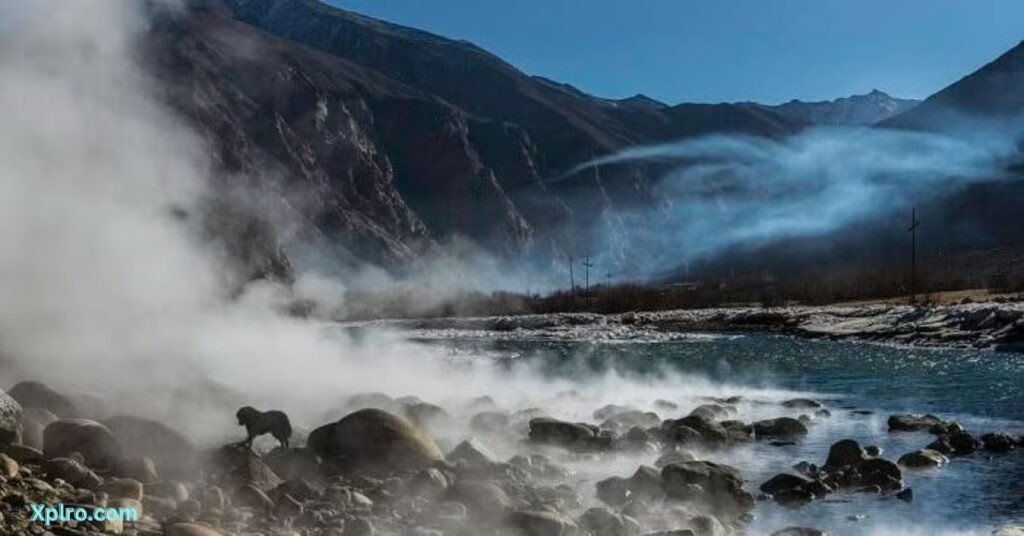
A short walk from Yumthang Valley’s heart, along a scenic path showcasing the valley’s lush beauty, lie the Yumthang Hot Springs. These natural springs, rich in sulfur and minerals, have been revered for their therapeutic properties for generations. Travelers seeking relaxation and a touch of natural healing are drawn to these steaming pools.
A simple hut with two pools marks the location. Here, the warm, mineral-rich water bubbles up from the earth, offering a stark but welcome contrast to the cool mountain air. Locals believe the high sulfur content can alleviate various ailments. Especially during winter, when snow blankets the valley, sinking into these soothing waters becomes an unforgettable experience.
Lachung Village:
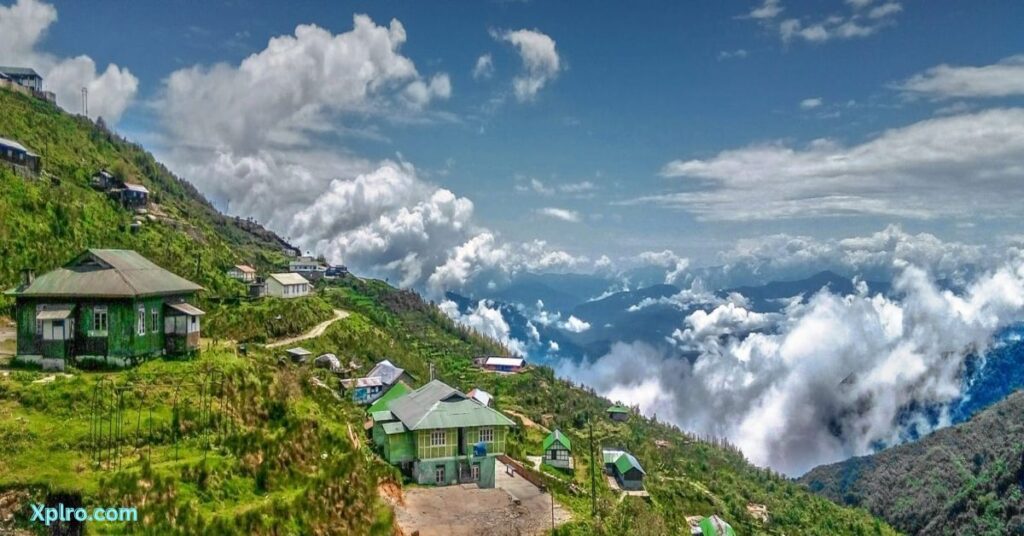
Twenty-four kilometers from the vibrant Yumthang Valley, Lachung Village emerges as a tranquil gateway to Sikkim’s captivating beauty. Nestled at an elevation of 8,610 feet, this village is a visual poem. Imagine snow-capped peaks forming a majestic backdrop, lush green forests carpeting the slopes, and idyllic apple orchards painting the landscape with color. Breathe in the crisp mountain air – a refreshing welcome for any visitor.
Lachung is the heartland of the Bhutia and Lepcha communities, known for their warmth and rich cultural heritage. As you explore the village, traditional wooden houses adorned with colorful prayer flags will line the streets. Buddhist monasteries, serene and spiritual, stand alongside vibrant local markets brimming with life.
Zero Point:
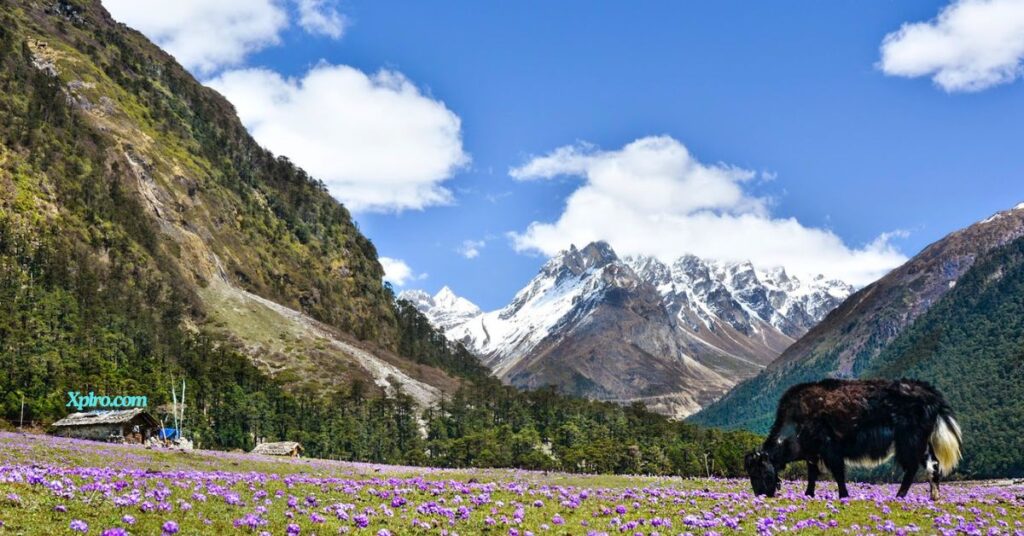
Twenty-three kilometers beyond the verdant embrace of Yumthang Valley, Yumesamdong, also known as Zero Point, unveils itself. This crown jewel of Sikkim sits perched at a dizzying 15,300 feet, marking the final point accessible by civilian vehicles. Here, the landscape undergoes a dramatic transformation, morphing into a breathtaking tapestry of snow-clad peaks that dominate the horizon for most of the year.
The journey to Yumesamdong is an adventure in itself. The road winds through rugged terrain, offering glimpses of glacial rivers carving their paths through the valleys and snow-capped giants reaching for the sky. As you reach your destination, prepare to be awestruck by panoramic vistas of the majestic Himalayas, their peaks adorned in a pristine white mantle.
Yumthang River:
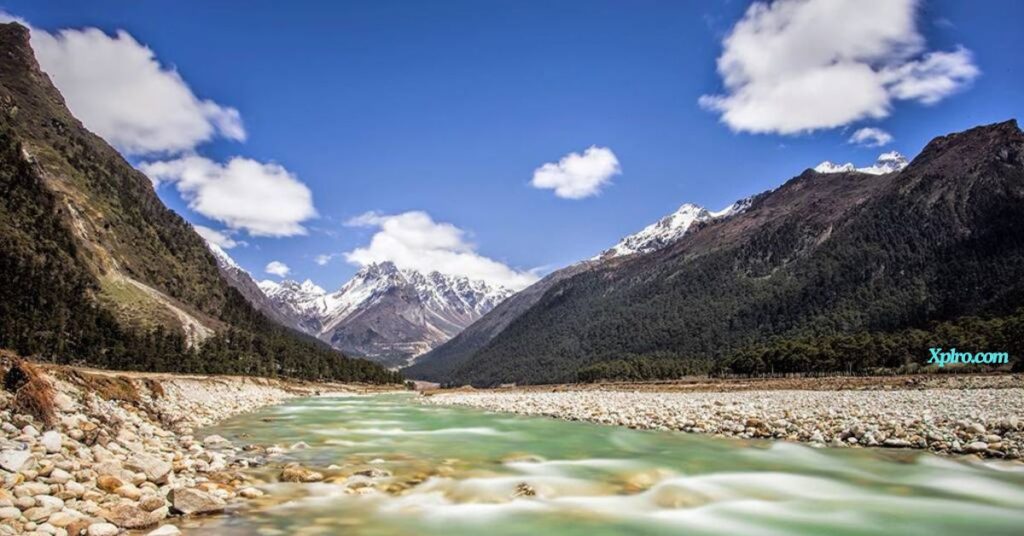
Twenty-three kilometers beyond the verdant embrace of Yumthang Valley lies Yumesamdong, also known as Zero Point. This breathtaking crown jewel of Sikkim sits perched at a staggering 15,300 feet, marking the final point accessible by civilian vehicles. As you ascend, the landscape undergoes a dramatic transformation. Rolling meadows morph into a breathtaking tapestry of snow-clad peaks that dominate the horizon year-round.
The journey to Yumesamdong is an adventure in itself. The road winds through rugged terrain, offering glimpses of glacial rivers carving their paths through the valleys below. Towering giants, their snow-capped peaks reaching for the sky, line the route.
Local Experiences:
- Immerse in Local Culture: Explore nearby villages to witness Bhutia and Lepcha traditions. Admire their unique wooden houses adorned with colorful prayer flags.
- Savor Local Cuisine: Tantalize your taste buds with momos, thukpa, and gundruk – authentic Sikkimese dishes prepared with fresh, local ingredients.
- Explore Spiritual Sites: Visit Lachung Monastery for a glimpse into local religious practices and breathtaking valley panoramas. Participate in prayer sessions for deeper understanding.
- Experience Vibrant Festivals: Immerse yourself in the energy of Losar (Tibetan New Year) and Saga Dawa festivals. Witness traditional dances, music, and rituals for a deeper connection with the local way of life.
- Discover Local Treasures: Browse vibrant markets overflowing with handcrafted souvenirs: textiles, carpets, wooden artifacts, prayer flags, thangka paintings, and yak wool products.
- Unforgettable Yak Ride: Embark on a unique perspective-shifting yak ride through scenic meadows. Learn about the importance of yaks in the local economy and culture, appreciating their role in agriculture and transportation.
- Relax in Natural Warmth: Unwind and rejuvenate in the natural warmth of the Yumthang Hot Springs, renowned for their therapeutic properties. Soak in the breathtaking beauty of the surrounding valley.
- Embrace Nature’s Tranquility: Take leisurely walks along the Yumthang River, savoring the serene ambiance and capturing stunning views. Pack a picnic and enjoy a meal amidst lush meadows bursting with vibrant flora.
- Wildlife Paradise Awaits: Explore the Shingba Rhododendron Sanctuary, a haven for diverse plant and bird species. Spot yaks and other local wildlife in their natural habitat, adding to the region’s charm.
- Capture Lasting Memories: From blooming rhododendrons to snow-capped peaks, Yumthang Valley is a photographer’s paradise.
Travel tips:
- Permits: An Inner Line Permit (ILP) is mandatory for entry. Arrange it through registered travel agents in Gangtok or the tourism office. Carry a passport-sized photo, valid ID, and a photocopy of your passport or Aadhar card.
- Clothing: Pack warm layers year-round as temperatures drop significantly, especially at night. In winter, bring heavy woolens, thermals, gloves, and a good jacket.
- Footwear: Sturdy shoes or hiking boots are essential, especially for exploring. Opt for waterproof shoes during monsoons.
- Altitude Sickness: Yumthang Valley is high-altitude. Acclimatize in Gangtok or Lachung to avoid altitude sickness. Stay hydrated, avoid alcohol, and eat light meals.
- Health and Safety: Pack a basic first-aid kit and any personal medications. Carry sunscreen, sunglasses, and lip balm for sun protection.
- Travel Insurance: Consider travel insurance, especially if planning adventurous activities like skiing. It should cover high-altitude trekking.
- Transportation: Hire a reliable taxi or shared vehicle (pre-book during peak season) as roads can be challenging. Experienced drivers are recommended.
- Cash: ATMs are scarce. Carry enough cash as credit/debit card facilities may be limited in villages and towns.
- Eco-Friendliness: Respect the environment. Avoid littering, use reusable water bottles, and leave no trace.
- Local Culture: Dress modestly, especially at monasteries. Be respectful of customs and traditions. Ask permission before photographing people.
- Accommodation: Book your stay in advance, especially during peak seasons. Options range from guesthouses in Lachung to basic lodges in the valley.
- Food and Water: Stick to bottled or purified water. Enjoy local cuisine, but ensure food is freshly cooked and hygienic.
- Connectivity: Mobile network coverage can be unreliable. Inform family and friends of your travel plans. Download offline maps and keep physical copies of important information.
- Local Guides: Consider hiring a local guide for deeper insights into the valley’s flora, fauna, and cultural heritage.
- Weather Updates: Check the weather forecast and road conditions before your trip, especially during monsoons and winter when landslides and roadblocks can occur.
Conclusion
Sikkim’s “Valley of Flowers,” Yumthang Valley, captivates year-round. Witness a riot of colors in spring as the Shingba Rhododendron Sanctuary blooms. Winter transforms the landscape into a snowy wonderland, perfect for relaxing in the natural warmth of the hot springs. Explore nearby Lachung Village and delve into the rich traditions of the Bhutia and Lepcha communities. Adventure seekers can conquer the trails to Zero Point, while nature lovers can enjoy peaceful walks along the Yumthang River. Immerse yourself in vibrant local festivals and embrace responsible travel practices. Let Xplro.com [Insert link to Yumthang Valley on Xplro.com if available] be your guide to planning an unforgettable escape to this captivating Himalayan gem.
FAQs
What is Yumthang Valley famous for?
- Yumthang Valley is renowned for its stunning natural beauty, especially during spring when it transforms into the “Valley of Flowers” with a vibrant display of rhododendrons and alpine flowers.
How do I reach Yumthang Valley?
- To reach Yumthang Valley, you typically travel from Gangtok to Lachung by road, which takes approximately 6-7 hours. From Lachung, it’s another 1-2 hours by car to Yumthang.
What is the best time to visit Yumthang Valley?
- The best time to visit Yumthang Valley is from late February to mid-June for blooming flowers, or from September to December for clear skies and pleasant weather.
Do I need a permit to visit Yumthang Valley?
- Yes, visitors require an Inner Line Permit (ILP) to visit Yumthang Valley. These permits can be obtained from the tourism office in Gangtok or through registered travel agents.
What should I pack for a trip to Yumthang Valley?
- Pack warm clothing, especially during winter, as temperatures can drop significantly. Sturdy walking shoes or boots are recommended for exploring the valley.
Are there accommodation options in Yumthang Valley?
- Accommodation options are limited in Yumthang Valley itself. Most visitors stay in nearby Lachung, where there are guesthouses and hotels catering to tourists.
What activities can I do in Yumthang Valley?
- Popular activities include visiting the Shingba Rhododendron Sanctuary, soaking in the Yumthang Hot Springs, trekking to Zero Point, and enjoying yak rides in the valley.
Is there mobile network coverage in Yumthang Valley?
- Mobile network coverage can be unreliable in Yumthang Valley and surrounding areas. It’s advisable to inform your contacts about limited connectivity.
What are the safety considerations for visiting Yumthang Valley?
- Visitors should acclimatize to the high altitude gradually to avoid altitude sickness. It’s also essential to respect local customs and traditions, especially when visiting monasteries.
Can I visit Yumthang Valley during the monsoon season?
- While possible, visiting during the monsoon season (July to early September) can be challenging due to heavy rainfall, which may cause landslides and road closures.
What dining options are available in Yumthang Valley?
- Dining options are limited in Yumthang Valley itself. It’s recommended to eat at your accommodation in Lachung or nearby eateries offering local cuisine.
Are guided tours available for Yumthang Valley?
- Yes, guided tours and trekking packages are available from travel agencies in Gangtok and Lachung. Local guides provide insights into the valley’s flora, fauna, and culture.




